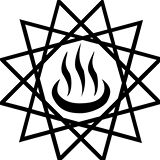The Lesser Mysteries of Eleusis
by Gitana
Originally published in Rosicrucian Digest Volume 90 Number 2 2009
The town of Eleusis, twelve miles from Athens, was home to the famous Eleusinian Mysteries. People would come from all parts of Greece to be initiated into this cult of “The Two Goddesses,” Demeter and Persephone. The Mysteries consisted of two parts, the Lesser Mysteries, which were conducted in the spring (Athenian month of Anthesterion), and the Greater Mysteries, which took place in the autumn (Athenian month of Boedromion).
The Lesser Mysteries can best be characterized as a preliminary purification that a candidate must undergo before taking part in the Greater Mysteries. [1] Even Socrates comments that one is not permitted to be initiated into the Greater Mysteries without having first been initiated into the Lesser. [2] Plutarch wrote that “in mystery initiations one should bear up to the first purifications and unsettling events and hope for something sweet and bright to come out of the present anxiety and confusion.” [3] The ancient Greeks believed that participation in the Mysteries was of great importance, as it was the most popular cult of ancient Greece. Plato explains that “Whoever arrives in Haides as an uninitiate and non-participant in the initiation rites will lie in mud, but he or she who has been both purified and has participated in the initiation rites, upon arrival there, will dwell with the gods.” [4]
Scholars have reason to believe that prior to the fifth century BCE, these purification rituals took place in the courtyard of the Eleusinian Telesterion. [5] However, there were also very similar purification rituals that were taking place in Athens, near the Ilissos River. Around the middle of the fifth century, the sacred officials from Eleusis decided that the Athenian purifications could serve as the necessary prerequisite to the Greater Mysteries. [6] Thus, a new tradition began, in which candidates underwent the initial purifications in Athens in the spring. [7] In the fall of the next year, they were eligible to participate in the Greater Mysteries in Eleusis. The only change to this tradition was in 215 BCE, when officials added an optional repetition of the Lesser Mysteries. [8] This repetition was held the month before the Greater Mysteries, and was open to anyone who had traveled to Athens, but missed the opportunity to attend the spring rites, or simply to accommodate the large number of people wishing to be initiated. This continued until the fourth century CE, when the Mysteries, and all other pagan practices, were outlawed by the Christian Emperor. However, a small temple, which was still standing in the mid-1700s, may have been one of the temples where the Lesser Mysteries were held. [9]
The rituals of the Lesser Mysteries were often called the myesis, as opposed to the rites of the Greater, which were called epopteia. [10] The word myesis means “to teach” and also “to initiate.” [11] Epopteia has a similar meaning, but with an important difference; it means “to witness” and “to be initiated.” The slight differences in these two words explain a fundamental difference in what happened to the initiates during these two sets of rituals. In the Lesser Mysteries, candidates were taught the theology of the Two Goddesses, and the meaning of the rites of the Mysteries. However, in the Greater Mysteries, they could experience what they had learned, and near the end of the week-long festival, they would even see a vision of Persephone. Clement of Alexandria wrote: “The Mysteries of the Greeks begin with purification…. There are the Lesser Mysteries, which have a function of teaching and preparation for the Mysteries to come, and the Greater Mysteries concern everything, where it is no longer a matter of learning but contemplating and pondering nature and concrete realities.” [12] As we all surely know, it is one thing to have something explained to you, but another thing entirely to experience it firsthand.
Surviving Artwork Offers Clues
What exactly was taught to the initiates we do not know. As was also the case with the Greater Mysteries, the initiates were required to keep a vow of silence in regards to what they heard and saw during the rituals. We are fortunate to have some surviving artwork that depicts some scenes from these purification rituals. This is most interesting, because depicted are mythological scenes in which Herakles is undergoing the rites of the Lesser Mysteries.
One may recall that of the Twelve Labors of Herakles, the final task was for him to go to the Underworld for the dreaded three-headed dog, Kerberos. [13] This was thought to be a most impossible task, as no mortal had ever before journeyed to the Underworld and returned. While making this journey, Herakles came face to face with the goddess Persephone. The only way that Herakles could have stood before the Queen of the Underworld, and yet be permitted to leave, was if he had previously been initiated into her Mysteries. [14] In a play by Euripides, Herakles says, “I have succeeded because I have seen the sacred actions in Eleusis.” [15] According to myth, the purification rituals of the Lesser Mysteries were actually invented for the sake of Herakles. [16] As was standard for any religious ritual, one was not allowed to participate if stained with míasma, or ritual impurity. Among other things, murder was regarded as an act that brought míasma upon a person. Herakles certainly killed people as well as monsters. In order to rid him of the míasma certain purification rituals had to be performed. Thus the Lesser Mysteries were created, or so the story goes.
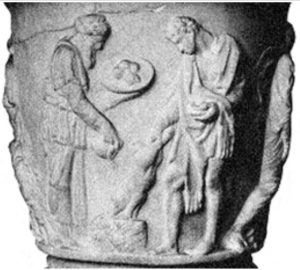
We now return to this artwork that depicts the purification ritual. If we look at the Lovatelli urn we can clearly see three distinct ritual actions. The first scene shows Herakles holding a pig over a low altar. This altar is called an eskhara, and is used when making offerings to chthonic deities. From this we can infer that the offering was given to Persephone. In his other hand he holds a stack of round cakes, called pelanoi, which will be offered next. [17] The actual act of offering the pelanoi, however, is not depicted on the urn. We also see a priest pouring a libation, most likely of water, onto this same altar. He also is holding an offering tray. The items aren’t clearly distinguishable, but Kerényi suggests they are poppies. [18] Poppies are a common symbol in images of Demeter and Persephone. Demeter is said to have used poppies in an effort to forget her grief of Persephone’s abduction by Haides. The flower also is seen in connection with Persephone and other chthonic gods due to their potential lethal effects. However, the items on the priest’s tray could also be pomegranates, spherical cakes, or cheese, which Clement of Alexandria says are offered during the Greater Mysteries. [19] We really don’t know for sure. It was after these offerings that the initiate was told certain myths, which Socrates says are inappropriate to tell before children, [20] and the meanings of them were explained.
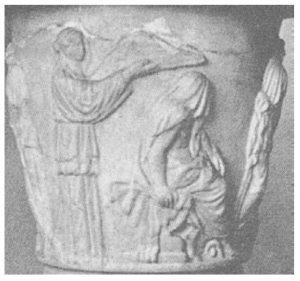
In the next action on the urn we see a veiled Herakles on a seat with a priestess holding something over his head. The seat is covered with a ram’s fleece, sometimes referred to as the “fleece of Zeus.” We know which animal it comes from as the horns of the ram’s head are visible by Herakles’ feet. In the Homeric Hymn to Demeter, she also sits on a ram’s fleece while grieving the abduction of her daughter Persephone. [21] According to a general survey of Greek literature, a ram is the most often mentioned sacrificial animal presented to Persephone. Perhaps the ram was sacrificed just before the initiate sat on the animal’s fleece. We cannot be sure, as the act of sacrificing the ram is not shown on the urn.
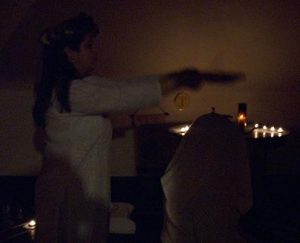
Herakles also has a cloth draped over his head and back, which covers his face, and prevents him from seeing. While the initiate is unable to see, he or she is led by a mystagogue. [22] This act of covering an initiate’s eyes, whether with a cloth, blindfold, or by other means, is a common feature of initiation ceremonies throughout history and across cultures. Kerényi explains its importance in the following passage:
Herakles is seated with his head totally covered: the Mysteria begin for the mystes when, as sufferer of the event (muoúmenos), he closes his eyes, falls back as it were into his own darkness, enters into the darkness. The Romans use the term “going-into,” in-itia (in the plural), not only for this initiating action, the act of closing the eyes, the myesis, which is exactly rendered as initiatio, but for the Mysteria themselves. A festival of entering into the darkness, regardless of what issue and ascent this initiation may lead to: that is what the Mysteria were, in the original sense of the word. [23]
A few pages later he also writes, “It is in threefold darkness—the darkness of the veiling, that of the sacred nights in Agrae and Eleusis, and his own inner darkness—that the mystes find their way back to their own suffering, and conceiving motherliness.” [24]
We also see the priestess holding a winnowing fan, or liknon, over Herakles’ head. This is a type of basket used to separate the wheat from the chaff. Its connection to Demeter and Persephone, goddesses of the grain, is obvious. The action can also be described as a type of sympathetic magic. The wheat is purified, and so is the initiate. The liknon is also a common symbol in the cult of Dionysos. In such a context, separating the wheat from the chaff then becomes a metaphor for separating the soul from its outer casing, the body. [25] Although such a teaching is more Orphic than it is Eleusinian, it would seem that the metaphor is still applicable. One ancient author says that Musaeus, the son of Orpheus, was once one of the main priests in Eleusis. [26]
Purification by Water, Air, Fire
At this point the purification ritual is complete. According to one ancient author, the initiates were purified by the elements of water, air, and fire. [27] We have seen the water in the priest’s libation, the air with the liknon, and the fire from the torches and on the altar. Now, in a state of purity, the initiate may approach the goddess. In the final scene on the urn, we see the initiate stepping toward the seated Demeter. She is sitting on the kiste, the basket which holds the ritual implements of the Greater Mysteries. The new initiate approaches and holds out his right hand to touch the snake. About this act, Burkert says, “A snake coils from the kiste to Demeter’s lap, and the mystes, distinguished by his bundle of twigs, is seen touching this snake without fear—having transcended human anxiety, moving free and relaxed in a divine sphere.” [28] The snake represents mysteries in general. In fact, it is such a common symbol associated with various mystery cults, that one is even featured on the cover of Burkert’s book, Ancient Mystery Cults. Reaching out for the snake indicates that the initiate is ready to receive the Mysteries. Notice that Demeter is not handing the snake to him. She is, in fact, turning away from him, and looking behind her, at the approaching Persephone. Demeter remains sitting on the kiste, as these items will not be revealed until the Greater Mysteries. She also stands between the initiate and Persephone, another indication that the whole process of initiation is not yet completed.
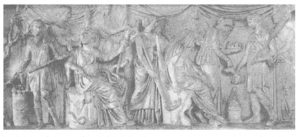
One can also see almost identical scenes depicted on a sarcophagus from Torre Nova. Represented are the pouring of libations over a low altar, offering trays, the veiled initiate on a chair, with priestess standing behind him, and Demeter sitting on the kiste with the snake in her lap. We can say with almost certainty that these actions, then, must have been performed during the Lesser Mysteries.
It might seem odd to some that there would be separate purification rituals that one had to undergo before being admitted to the Greater Mysteries. However, almost all mystery religions have preliminary purification rituals that one must undergo before close contact with the Divine is permitted. [29] Furthermore, one should keep in mind that the goddess Persephone is always associated with purity. One of her epithets is hagne or “pure.” The term “creates a field of forces that demands reverence and distance.” [30] The opening line of one of the Orphic Gold Tablets from Thurii reads: “Pure I come from the pure, Queen of those below.” For a goddess whose own purity is beyond measure, one must take extra precautions when preparing one’s self.
Endnotes
1 Sometimes the Greater Mysteries are simply called “The Mysteries.” I will use the terms “Greater” and “Lesser” in this article to make a clear distinction between the two different sets of rituals.
2 Plato, Gorgias, 467c.
3 Plutarch, De aud. poet. 47a.
4 Plato, Phaedo, 69c.
5 Inscriptiones Graecae I2 , ed. F. Hiller von Gaertringen (Berlin: G. de Gruyter, 1924), 6 125 (IG I2 6 125).
6 Carl Kerényi, Eleusis: Archetypal Image of Mother and Daughter (Princeton: Princeton University Press, 1967), 48.
7 It is the Athenian rituals which will be the focus of this article.
8 Inscriptiones Graecae II2, ed. J. Kirchner (Berlin: 1878-1882), 847 22 (IG II2 847 22).
9 A painting shows what the temple looked like during the “Turkish Period” and is reproduced in Kerényi, Eleusis, plate 8, 49.
10 Kerényi, Eleusis, 45.
11 There is some evidence that the Mysteries might have a precursor from Mycenaean times, as well as a word that is etymologically related to myesis. (G.E. Mylonas, Eleusis and the Eleusinian Mysteries [Princeton: Princeton Univ. Press, 1961], 29-54; Walter Burkert, Ancient Mystery Cults [Cambridge: Harvard Univ. Press], 1987, 8-9.)
12 Clement of Alexandria, Stromata 5.70.7-71.1.
13 We have come to know Kerberos as a dog that has three heads. However, various ancient authors describe the creature differently. For example, Hesiod, in the Theogony (310) says the beast has 50 heads. Apollodoros says “Kerberos had three dog-heads, a serpent for a tail, and along his back the heads of all kinds of snakes.” (Bibliotheca 2.122.) All sources do agree that it is a ferocious monster.
14 Apollodoros, Bibliotheca II v 12.
15 Euripides, Madness of Herakles, 613.
16 Aristophanes Scholium, Plutus 845; 1013.
17 The pelanoi are most likely made from barley meal and honey.
18 Kerényi, Eleusis, 55.
19 Clement of Alexandria, Protrepticus II.22.
20 Plato, Republic, 378a.
21 Homeric Hymn to Demeter, 192-211.
22 Kevin Clinton, “Stages of Initiation in the Eleusinian and Samothracian Mysteries,” in Greek Mysteries: The Archaeology of Ancient Greek Secret Cults, ed. M. Cosmopoulos (New York: Routledge , 2003), 50.
23 Carl Kerényi, “The Mysteries of the Kabeiroi,” in The Mysteries: Papers from the Eranos Yearbooks, ed. J. Campbell (Princeton: Princeton Univ. Press, 1971), 39.
24 Ibid., 41.
25 For more information on the Orphic process of purifying the soul from the body, see previous issue of the Rosicrucian Digest (vol. 86, no. 1, 2008) on Orphism.
26 Diodorus Siculus Bibliotheca Historica, IV, 25.
27 Servius, Aen. 6.741.
28 Burkert, Ancient Mystery Cults, 94.
29 Fritz Graf, “Lesser Mysteries—Not Less Mysterious,” Greek Mysteries, Cosmopoulos, 244.
30 Walter Burkert, Greek Religion (Cambridge: Harvard Univ. Press, 1985), 271.
